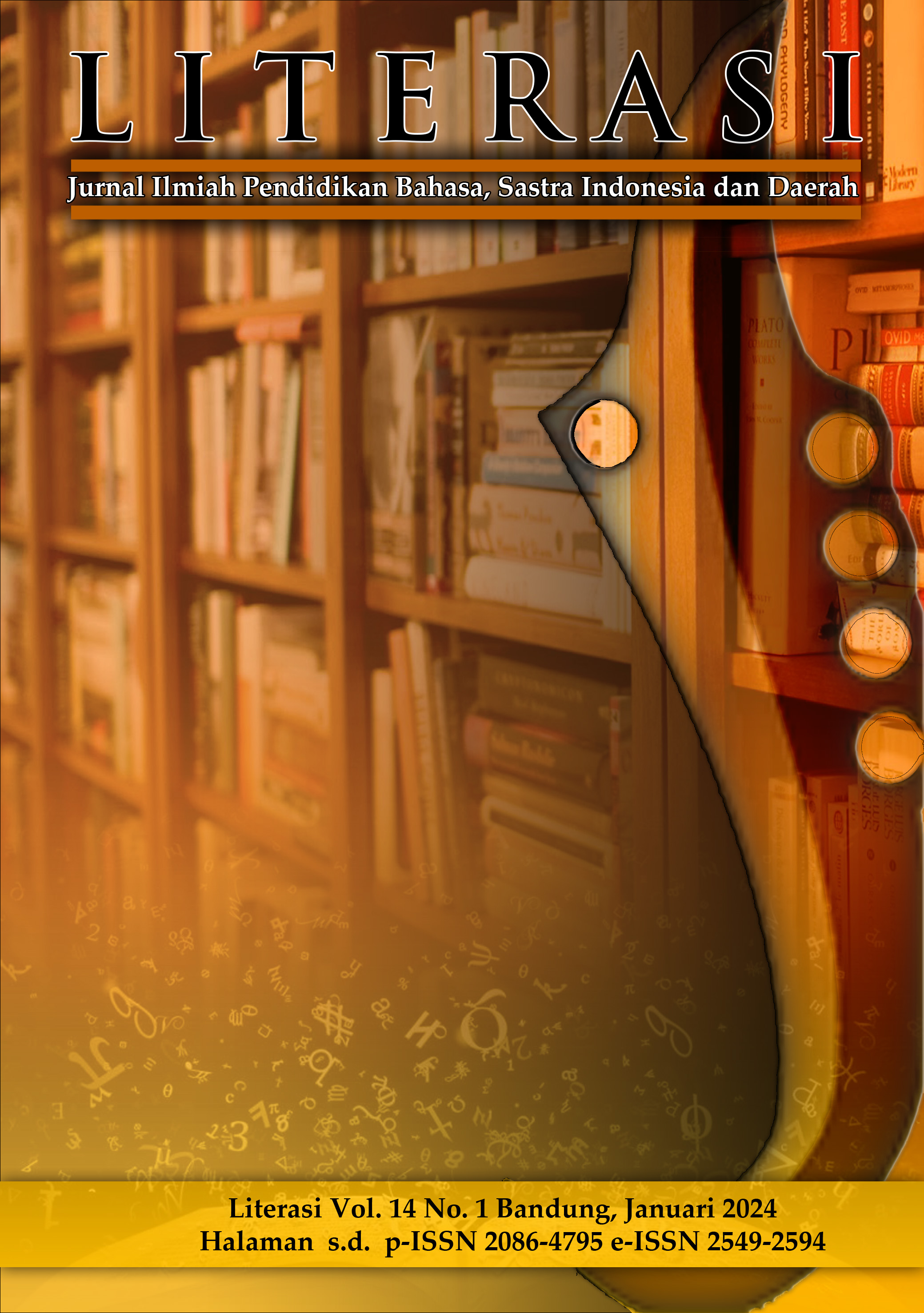KEVARIASIAN KALIMAT DALAM TEKS EKSPLANASI KARYA SISWA
VARIATIONS IN SENTENCE OPENINGS, SENTENCE PATTERNS, AND SENTENCE TYPES
DOI:
https://doi.org/10.23969/literasi.v14i1.10277Keywords:
sentences, explanatory text, variety, SENTENCEAbstract
Sentences have an important role in spoken and written language activities. Units of thought, idea, or message in a sentence must be able to be conveyed clearly by a speaker and writer. The ideas in explanatory text are no exception. This explanation is packaged, among other things, in the form of definitions, arguments, clarifications, classifications, interpretations and constructions. The use of effective sentences should be applied by class VIII junior high school students in writing explanatory texts. If students can apply the rules of effective sentences, then the written explanatory text can be easily understood by readers and does not give rise to multiple interpretations. This research uses a qualitative approach. The data in this research are in the form of effective and ineffective sentences contained in the explanatory text written by students of SMPN 1 Turen class 8 based on the aspects of variation, parallelism, economy and completeness. The data source for this research is a collection of explanatory texts by students of SMPN 1 Turen class 8 obtained from teachers who teach Indonesian language subjects. Based on variation, variations were found in sentence opening. Each sentence begins with a noun, adverb of time, verb, and conjunction. Sentences with different types of nouns, adverbs of time, verbs and conjunctions were found. Apart from variations in openings, variations in sentence patterns were also found consisting of subject-predicate-complement (S-P-Pel), predicate-subject-object (P-S-O), object-subject-predicate (O-S-P), subject-adverb-predicate (S-K-P) patterns. ), and adverb-subject-predicate (K-S-P).
Downloads
References
Akhadiah, S., M.G. Arsyad & S.H. Ridwan. (1988). Pembinaan Kemampuan Menulis Bahasa Indonesia. Jakarta: Erlangga.
Almanshur C, F. & Ghony D. 2012. Metodologi Penelitian kualitatif. Yogyakarta: Ar‐Ruzz Media
Amril, K.J. & Emidar. 2020. Keefektifan Kalimat pada Teks Berita Siswa Kelas VIII SMP. Jurnal Pendidikan Bahasa dan Sastra Indonesia, 9(20). Dari http://ejournal.unp.ac.id/index.php/pbs/article/view/108988.
Anggraini, A. 2006. Mengasah Keterampilan Menulis Ilmiah di Perguruan Tinggi. Yogyakarta: Graha Ilmu.
Arifin, Z. & Tasai, A. 2008. Cermat Berbahasa Indonesia Untuk Perguruan Tinggi. Jakarta: Akademika Presindo.
Isnatun dan Farida. (2013). Mahir Berbahasa Indonesia. Bogor: Yudhistira
Kosasih. (2014). Jenis-jenis Teks. Yrama Widya: Bandung
Priyatni, E. T. 2014. Desain pembelajaran Bahasa Indonesia dalam Kurikulum 2013. Jakarta: Bumi Aksara.
Putrayasa, I. B. 2007. Kalimat Efektif: Diksi, Struktur dan Logika. Bandung: Refika Aditama
Rahardi, R. Kunjana. 2009. Bahasa Indonesia untuk Perguruan Tinggi. Jakarta: Erlangga.
Soedjito. 1990. Kalimat Efektif. Bandung: Remaja Karya CV
Soedjito & Saryono. 2012. Tata Kalimat Bahasa Indonesia. Yogyakarta: AM Publishing.
Sugiyono. 2012. Mehami Penelitian Kualitatif. Bandung: Alfabeta.
Suherli, Suryaman M., Septiaji A. & Istiqomah. 2017. Buku Guru Bahasa Indonesia Kelas X Revisi Tahun 2017. Jakarta: Pusat Kurikulum dan Perbukuan, Balitbang, Kemendikbud.
Sumadi. 2013. Sintaksis Bahasa Indonesia. Malang: A3
Suparno & Yunus. 2007. Keterampilan Dasar Menulis. Jakarta: Universitas Terbuka
Widjono. 2012. Bahasa Indonesia Mata Kuliah Pengembangan Kepribadian di Perguruan Tinggi. Jakarta: Grasindo.
Downloads
Published
Issue
Section
License
Copyright (c) 2024 Literasi: Jurnal Ilmiah Pendidikan Bahasa, Sastra Indonesia dan Daerah

This work is licensed under a Creative Commons Attribution 4.0 International License.
Hak cipta artikel yang diterbitkan di jurnal ilmiah dimiliki oleh penerbit, bukan penulis. Hal ini berkaitan dengan koordinasi hak akses untuk cetak ulang atau penggunaan lainnya. Dalam hal ini penerbit mempunyai keluluasaan untuk mempublikasikan artikel sesuai dengan kesepakanan Transfer Agreement (penyerahan hak cipta) antara penerbit dengan penulis.















